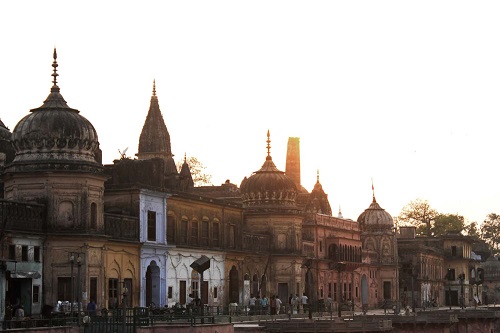The history of the Ayodhya Mandir, specifically referring to the contentious Ram Janmabhoomi site, is deeply intertwined with religious, historical, and political narratives. The city of Ayodhya, situated in the northern Indian state of Uttar Pradesh, has been a symbol of cultural and religious significance for centuries.
Ancient Roots
Ayodhya, situated on the banks of the Sarayu River, is considered the birthplace of Lord Ram, the seventh incarnation of Lord Vishnu according to Hindu beliefs. The ancient city is mentioned in various Hindu scriptures and revered for its association with the Ramayana.
Babri Masjid Construction (1528)
The construction of the Babri Masjid is attributed to the Mughal Emperor Babur, who commissioned its building in 1528. The mosque, named after him, became a prominent religious site.
Idols Placed Inside Babri Masjid (1949)
In 1949, idols of Lord Ram, along with the images of Goddess Sita and Lord Lakshman, were found inside the Babri Masjid. This discovery heightened tensions and led to the closure of the mosque.
Legal Battle Begins (1950s-1960s)
The legal dispute commenced in the 1950s when the Sunni Waqf Board filed a case claiming ownership of the disputed site. The case evolved over the years, becoming one of the longest-running legal battles in India.
Babri Masjid Demolition (December 6, 1992)
On December 6, 1992, a large gathering of Hindu activists, including leaders of the Bharatiya Janata Party (BJP) and Vishva Hindu Parishad (VHP), demolished the Babri Masjid. The event triggered widespread communal riots and resulted in significant social and political repercussions.
Ayodhya Act (1993)
In response to the Babri Masjid demolition, the Indian government enacted the “Ayodhya Act” in 1993. The Act aimed to maintain the status quo and protect the acquired land surrounding the disputed site.
Formation of Liberhan Commission (1992-2009)
The Liberhan Commission, established in 1992, investigated the circumstances leading to the Babri Masjid demolition. The commission’s report, submitted in 2009, highlighted political and administrative lapses that contributed to the event.
Supreme Court Intervention (2002)
In 2002, the Supreme Court intervened and ordered a status quo on the disputed site, preventing any religious activities. This decision aimed to maintain stability and prevent further communal tensions.
Allahabad High Court Verdict (2010)
The Allahabad High Court delivered a landmark verdict in 2010, dividing the disputed land into three parts. This included one-third for the Sunni Waqf Board, one-third for the Nirmohi Akhara, and one-third for the party representing the deity, Lord Ram.
Supreme Court Verdict (November 9, 2019)
In a historic judgment in 2019, the Supreme Court ruled in favor of the construction of a Ram Temple at the disputed site. The court acknowledged the significance of the site for Hindus and emphasized the unlawful nature of the Babri Masjid demolition.
Formation of Sri Ram Janmabhoomi Teerth Kshetra Trust (2020)
In 2020, the Sri Ram Janmabhoomi Teerth Kshetra Trust was established to oversee the construction of the Ram Temple. The trust is responsible for managing the entire temple complex.
Bhoomi Pujan (August 5, 2020)
On August 5, 2020, a grand Bhoomi Pujan ceremony took place to mark the formal commencement of the construction of the Ram Temple. Prime Minister Narendra Modi and various religious leaders attended the historic event.
Construction Commences (2020 Onwards)
– Following the Bhoomi Pujan, construction activities began in earnest. The temple complex is designed to incorporate traditional Hindu architectural elements and will be a symbol of cultural and religious significance.
Ongoing Construction
As of the latest updates, construction of the Ayodhya Ram Mandir is progressing steadily. The temple, once completed, is expected to stand as a testament to India’s cultural and religious diversity while serving as a place of worship for millions.
The official date of Ayodhya’s Ram Mandir opening is announced to be January 24, 2024. The history of the Ayodhya Mandir is a tale that crosses ancient religious beliefs, historical constructions, legal disputes, and political ploys.
It reflects the intricate interplay between faith, culture, and governance in the Indian context. The construction of the Ayodhya Ram Mandir marks a significant chapter, bringing both closure to a longstanding dispute and ushering in a new era for the sacred site in Ayodhya.
As the temple takes shape, it stands as a testament to the complexities and diversities that define India’s cultural and religious landscape.

